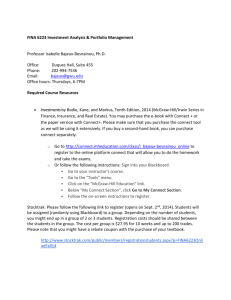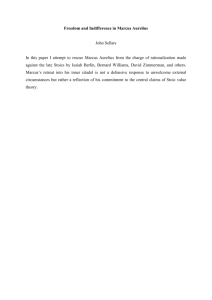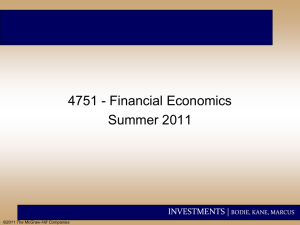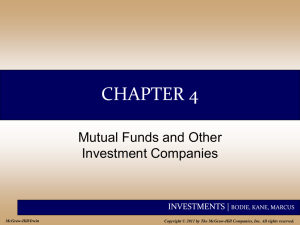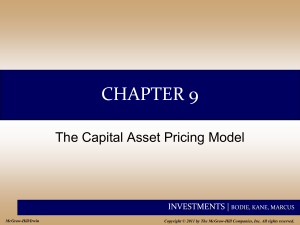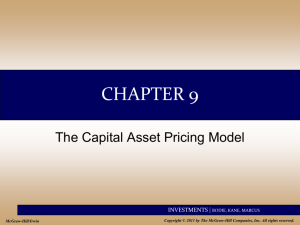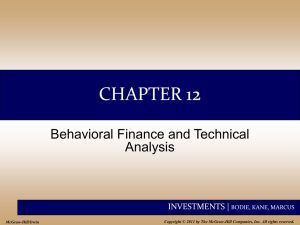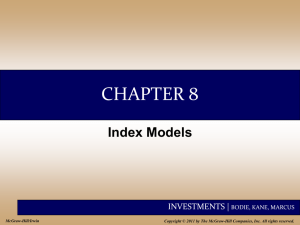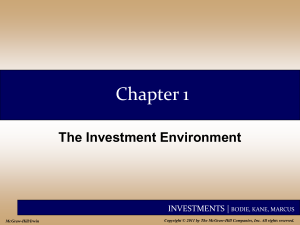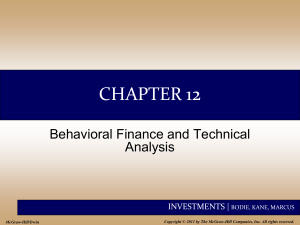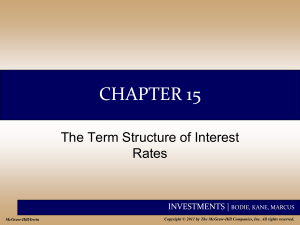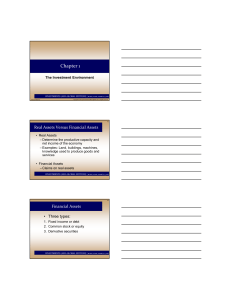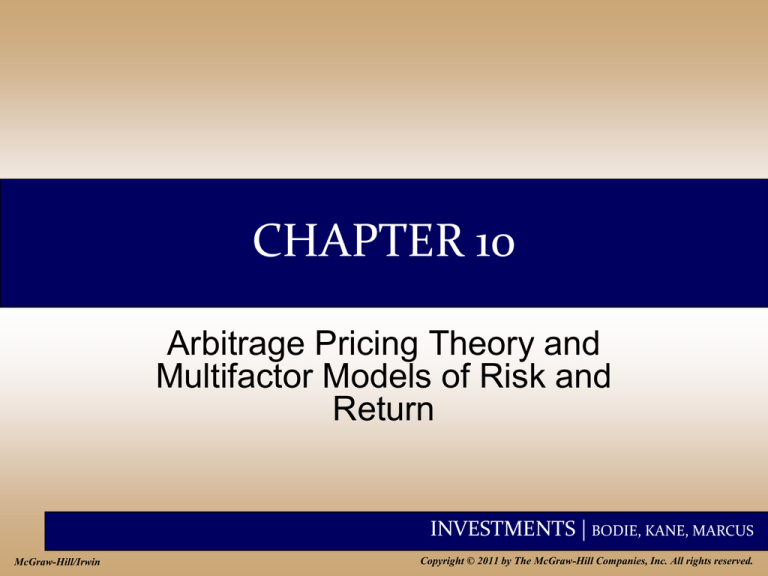
CHAPTER 10
Arbitrage Pricing Theory and
Multifactor Models of Risk and
Return
INVESTMENTS | BODIE, KANE, MARCUS
McGraw-Hill/Irwin
Copyright © 2011 by The McGraw-Hill Companies, Inc. All rights reserved.
10-2
Single Factor Model
• Returns on a security come from two
sources:
– Common macro-economic factor
– Firm specific events
• Possible common macro-economic
factors
– Gross Domestic Product Growth
– Interest Rates
INVESTMENTS | BODIE, KANE, MARCUS
10-3
Single Factor Model Equation
ri E (ri ) i F ei
ri = Return on security
βi= Factor sensitivity or factor loading or factor
beta
F = Surprise in macro-economic factor
(F could be positive or negative but has
expected value of zero)
ei = Firm specific events (zero expected value)
INVESTMENTS | BODIE, KANE, MARCUS
10-4
Multifactor Models
• Use more than one factor in addition to
market return
– Examples include gross domestic
product, expected inflation, interest
rates, etc.
– Estimate a beta or factor loading for
each factor using multiple regression.
INVESTMENTS | BODIE, KANE, MARCUS
10-5
Multifactor Model Equation
ri E ri iGDPGDP iIR IR ei
ri = Return for security i
βGDP = Factor sensitivity for GDP
βIR = Factor sensitivity for Interest
Rate
ei = Firm specific events
INVESTMENTS | BODIE, KANE, MARCUS
10-6
Multifactor SML Models
E ri rf iGDP RPGDP iIR RPIR
i
= Factor sensitivity for GDP
RPGDP = Risk premium for GDP
i IR = Factor sensitivity for Interest Rate
RPIR = Risk premium for Interest Rate
GDP
INVESTMENTS | BODIE, KANE, MARCUS
10-7
Interpretation
The expected
return on a
security is the
sum of:
1.The risk-free rate
2.The sensitivity to GDP
times the risk premium
for bearing GDP risk
3.The sensitivity to
interest rate risk times
the risk premium for
bearing interest rate
risk
INVESTMENTS | BODIE, KANE, MARCUS
10-8
Arbitrage Pricing Theory
• Arbitrage occurs if
there is a zero
investment
portfolio with a
sure profit.
Since no
investment is
required, investors
can create large
positions to obtain
large profits.
INVESTMENTS | BODIE, KANE, MARCUS
10-9
Arbitrage Pricing Theory
• Regardless of
wealth or risk
aversion, investors
will want an infinite
position in the riskfree arbitrage
portfolio.
• In efficient
markets, profitable
arbitrage
opportunities will
quickly disappear.
INVESTMENTS | BODIE, KANE, MARCUS
10-10
APT & Well-Diversified Portfolios
rP = E (rP) + PF + eP
F = some factor
• For a well-diversified portfolio, eP
– approaches zero as the number of
securities in the portfolio increases
– and their associated weights decrease
INVESTMENTS | BODIE, KANE, MARCUS
10-11
Figure 10.1 Returns as a Function of the
Systematic Factor
INVESTMENTS | BODIE, KANE, MARCUS
10-12
Figure 10.2 Returns as a Function of the
Systematic Factor: An Arbitrage Opportunity
INVESTMENTS | BODIE, KANE, MARCUS
10-13
Figure 10.3 An Arbitrage Opportunity
INVESTMENTS | BODIE, KANE, MARCUS
10-14
Figure 10.4 The Security Market Line
INVESTMENTS | BODIE, KANE, MARCUS
10-15
APT Model
• APT applies to well diversified portfolios and
not necessarily to individual stocks.
• With APT it is possible for some individual
stocks to be mispriced - not lie on the SML.
• APT can be extended to multifactor models.
INVESTMENTS | BODIE, KANE, MARCUS
10-16
APT and CAPM
APT
CAPM
• Equilibrium means no
arbitrage opportunities.
• APT equilibrium is
quickly restored even if
only a few investors
recognize an arbitrage
opportunity.
• The expected return–
beta relationship can be
derived without using the
true market portfolio.
• Model is based on an
inherently unobservable
“market” portfolio.
• Rests on mean-variance
efficiency. The actions of
many small investors
restore CAPM
equilibrium.
• CAPM describes
equilibrium for all assets.
INVESTMENTS | BODIE, KANE, MARCUS
10-17
Multifactor APT
• Use of more than a single systematic
factor
• Requires formation of factor portfolios
• What factors?
– Factors that are important to
performance of the general economy
– What about firm characteristics?
INVESTMENTS | BODIE, KANE, MARCUS
10-18
Two-Factor Model
ri E (ri ) i1F1 i 2 F2 ei
• The multifactor APT is similar to the
one-factor case.
INVESTMENTS | BODIE, KANE, MARCUS
10-19
Two-Factor Model
• Track with diversified factor portfolios:
– beta=1 for one of the factors and 0 for
all other factors.
• The factor portfolios track a particular
source of macroeconomic risk, but
are uncorrelated with other sources
of risk.
INVESTMENTS | BODIE, KANE, MARCUS
10-20
Where Should We Look for Factors?
• Need important systematic risk factors
– Chen, Roll, and Ross used industrial
production, expected inflation, unanticipated
inflation, excess return on corporate bonds,
and excess return on government bonds.
– Fama and French used firm characteristics
that proxy for systematic risk factors.
INVESTMENTS | BODIE, KANE, MARCUS
10-21
Fama-French Three-Factor Model
• SMB = Small Minus Big (firm size)
• HML = High Minus Low (book-to-market ratio)
• Are these firm characteristics correlated with
actual (but currently unknown) systematic risk
factors?
rit i iM RMt iSMBSMBt iHMLHMLt eit
INVESTMENTS | BODIE, KANE, MARCUS
10-22
The Multifactor CAPM and the APT
• A multi-index CAPM will inherit its risk
factors from sources of risk that a broad
group of investors deem important
enough to hedge
• The APT is largely silent on where to look
for priced sources of risk
INVESTMENTS | BODIE, KANE, MARCUS

